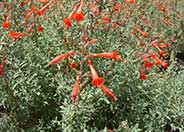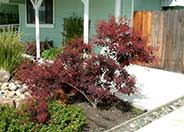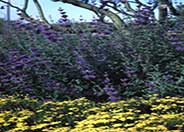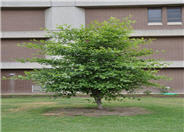
Common name:California Fuchsia, Zauschneria
Botanical name:Epilobium canum
The California fuchsia is a perennial with dense, narrow, green gray foliage and red orange summer flowers. The growth habit of this plant is sprawling and low. The California fuchsia is native to California, is drought tolerant, and attracts hummingbirds. -Cornflower Farms

Common name:Purple Smoke Tree
Botanical name:Cotinus coggygria 'Purpureus'
A deciduous shrub or small tree that grows up to 10' tall, the 'Purpureus' is grown for its wispy, thread-like flower clusters and outstanding fall color. Its foliage has a reddish purple color that turns somewhat green in summer. The plant requires sun to part shade, with little or no summer water. -Monterey Bay Nursery

Common name:Cleveland Blue Sage
Botanical name:Salvia clevelandii
The Cleveland Sage is a perennial shrub that grows 4' tall and wide. It has fragrant gray foliage and blue flowers that bloom between May and August. This shrub needs full sun and prefers well drained soil. The Cleveland Sage is native to California and is drought tolerant. -Cornflower Farms

Common name:Evergreen or Flowering Pear
Botanical name:Pyrus kawakamii
This tree grows quickly to about 20' tall and wide. It is has evergreen, glossy, oval, and pointed leaves. White, fragrant, spectacular flowers bloom in spring. Leaves may fall in winter if very cold. It prefers full sun and regular watering, more in hot summer months. Prune in winter. This tree looks great if espaliered. Fruit is inedible.

Common name:White Alder, Western Alder
Botanical name:Alnus rhombifolia
White Alder is a deciduous tree with spreading or ascending branches and downward pointing tips. It has coarse teeth and dark green leaves. It is very fast growing 50'-90' tall with a 40' spread. It is very heat and wind tolerant and is a native to California. Green yellow flowers appear in spring. During winter, small cones decorate bare limbs.
Designer: Cornflower Farms
Photographer: GardenSoft
Incorporate compost 6" into your soil to retain water, reduce compaction, feed earthworms, and provide valuable nutrients to your plants.
Check the soil's moisture level before watering.
You can reduce your water use 20-50% by regularly checking the soil before watering.
Remove irrigation water and fertilizer from areas where you don't want weeds to grow.